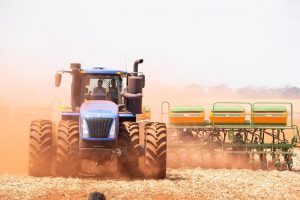Agriculture leaders in the United States House of Representatives are looking to provide at least an additional $10 billion in farmer aid to supplement the recently announced Farmer Bridge Assistance…
Soybean Planting in Brazil is Underway with Little Rainfall
Soybean planting, which promises to set a new record in Brazil, is underway in the Paraná, Mato Grosso do Sul, and Mato Grosso regions of the country. Agência Estado Letícia Pakulski writer reported that planting reached 0.7% of the area planned for the 2020-21 harvest last Thursday, according to a survey by consultancy AgRural. The number is lower than the five-year average of 2.7%.

The 2020-21 soybean crop should reach 37.86 million hectares in the country, an increase of 3% compared to the last harvest. The estimated volume is 133.5 million tons, an increase of 7.3%. The projection is from the National Supply Company (Conab). The National Opening of Soybean Planting happened last Thursday at Fazenda Dois Corações, in Capinópolis, Minas Gerais state, according to a report by Estado de Minas newspaper.
Em Capinópolis, Zema participa da Abertura Nacional do Plantio de Sojahttps://t.co/td59YNObSf
— Estado de Minas (@em_com) September 24, 2020
Valor Econômico writer Marcela Caetano highlighted that field work starts at a slow pace and more significant rains are expected in October. On the other hand, the rain forecast for the coming days should motivate more producers to put machines in the field.
Canal Rural writer José Florentino reported that international meteorological institutes point out that the formation of a La Niña in 2020 is practically certain. According the meteorologist at Somar Celso Oliveira, the effects of cooling the waters of the Pacific Ocean are already being felt.
The Canal Rural article added that “because of the phenomenon, there is a delay in the formation of humidity in the Amazon over the Midwest of the country. In addition, the cold fronts have not had the strength to advance and the most significant rains are restricted to Rio Grande do Sul state.”
Confira como foi a grande festa de Abertura Nacional do Plantio da Soja https://t.co/q0NHsSXsl3
— Canal Rural (@canalrural) September 25, 2020
A Globo Rural article explained that Mato Grosso farmers took advantage of the first rains to start planting this record soybean area, estimated at 10.2 million hectares by the Mato Grosso Institute of Agricultural Economics (Imea). Analysts at Imea recalled that last year the planting also started late because of the lack of rain, but farmers still had record production.
The perspective soybean plantings in each Brazilian state were reported by Canal Rural writer Daniel Popov. According the article, Paraná state will increase its planted area by 3%, Rio Grande do Sul state by 5%, and Goiás state by 4.5%.
“We are projecting an overall increase in area of over 3% in the country and above 4% in productivity. This is a preview, based on statistical models, also considering the acceleration in future sales,” Allan Silveira dos Santos, the superintendent of Conab’s Offer Management, said in the article.
The area planted with soybeans in Argentina, the second main producer in South America after Brazil, is also expected to increase. Agência Estado article noted that the area is expected to reach 17.2 million hectares in the 2020/21 crop, according to an estimate from the Buenos Aires Cereals Exchange. The projection represents an increase of 100,000 hectares, or 0.6%, compared to the previous cycle. The article added that the reduction of areas occupied by other crops, such as wheat, barley, sunflower and corn, will open space for soybeans.
Meanwhile, low stocks in Brazil and the appreciating dollar keep domestic prices of soybeans high. A 60 kilos bag (2,2 bushels) was sold for BRL 150.86 (USD 27.35) on September 24, a nominal record in the historical series which began in March 2006 from the Center for Advanced Studies in Applied Economics (Cepea) of “Luiz de Queiroz” College of Agriculture at the University of São Paulo.
A Globo Rural article highlighted that the value is just slightly below the real record of BRL 153.40, recorded on August 31, 2012 (in deflated values). The article added that soy oil is traded above BRL 6.800 per ton, a nominal record for the Cepea series and the highest real level since March 2008.
Segundo o Cepea da Esalq/USP, Cotação da oleaginosa fechou a R$ 150,86 pela saca de 60 quilos na quinta-feira (24/9), pouco abaixo dos R$ 153,40 registrados em 31 de agosto de 2012https://t.co/Ok4Fk3H8Rj
— Globo Rural (@Globo_Rural) September 28, 2020
Last week, soybean prices in the interior of Paraná state exceeded sales values at the port of Paranaguá, according to information collected by Cogo – Inteligência em Agronegócio and reported at the Canal Rural website. In the countryside, the bag was negotiated at around BRL 150, while in the port, business was BRL 145.
Cogo: preço da soja no interior do Paraná supera valor no porto https://t.co/Va1YFGK5NF
— Canal Rural (@canalrural) September 22, 2020
The article added that this shows the lack of soybeans in the Brazilian market. The inversion of prices between the interior and the port is unprecedented in Brazil, according to Cogo.





